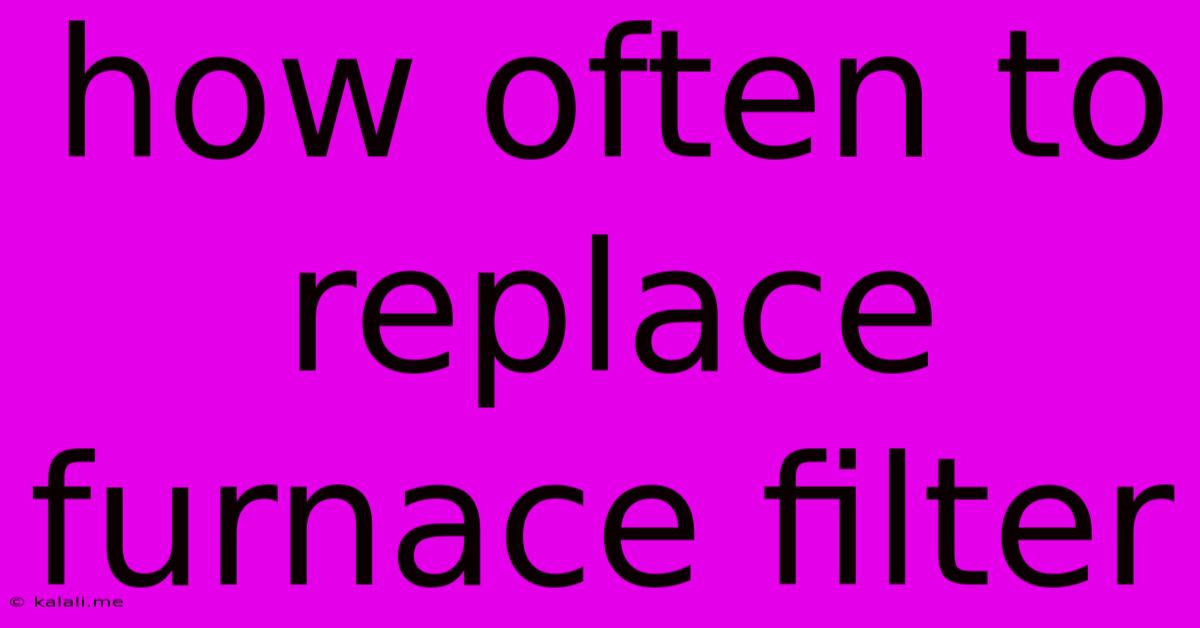How Often To Replace Furnace Filter
Kalali
May 24, 2025 · 3 min read

Table of Contents
How Often Should You Replace Your Furnace Filter? A Comprehensive Guide
Meta Description: Learn the optimal furnace filter replacement schedule to improve air quality, extend furnace lifespan, and save on energy costs. This guide covers different filter types and factors influencing replacement frequency.
Replacing your furnace filter regularly is crucial for maintaining a healthy indoor environment and ensuring your heating system runs efficiently. But how often is "regularly"? The simple answer is: it depends. This guide explores the various factors affecting filter replacement frequency and helps you determine the best schedule for your home.
Understanding Furnace Filter Types
Before diving into replacement schedules, let's clarify the different types of furnace filters:
-
Fiberglass Filters: These are the cheapest and least efficient, typically rated 1-inch. They trap larger particles but allow many smaller allergens to pass through. These require the most frequent replacement.
-
Pleated Filters: Offering better filtration than fiberglass, pleated filters have more surface area, trapping more dust, pollen, and other airborne particles. They come in various MERV (Minimum Efficiency Reporting Value) ratings, indicating their efficiency. Higher MERV ratings mean better filtration but can also restrict airflow, potentially straining your furnace.
-
HEPA Filters: High-Efficiency Particulate Air (HEPA) filters are the most effective, capable of trapping up to 99.97% of particles 0.3 microns or larger. They're ideal for allergy sufferers but require more frequent cleaning or replacement due to increased airflow restriction.
-
Electrostatic Filters: These filters use static electricity to attract and trap particles. They often require less frequent replacement than other types but may need periodic cleaning or washing.
Factors Affecting Filter Replacement Frequency
Several factors influence how often you should change your furnace filter:
-
Filter Type: As mentioned above, fiberglass filters need more frequent changes than pleated or HEPA filters.
-
Indoor Air Quality: Homes with pets, smokers, or people with allergies will require more frequent filter changes due to increased airborne pollutants.
-
Number of Occupants: More people in the house mean more dust and dander, necessitating more frequent filter replacements.
-
Household Activity: Construction, renovation, or other activities that generate dust will increase the rate at which your filter becomes clogged.
-
Climate: During periods of high pollen or dust, you might need to change your filter more often.
-
Furnace Usage: The more you use your furnace, the faster the filter will become clogged.
Recommended Replacement Schedules
While there's no one-size-fits-all answer, here's a general guideline:
-
Fiberglass Filters: Replace every 1-2 months, or more frequently if needed.
-
Pleated Filters (low MERV rating): Replace every 3-4 months.
-
Pleated Filters (medium MERV rating): Replace every 4-6 months.
-
Pleated Filters (high MERV rating): Replace every 6-12 months, depending on usage and air quality.
-
HEPA Filters: Replace every 6-12 months or as needed, based on visual inspection.
How to Tell When to Replace Your Filter
Don't rely solely on a scheduled replacement. Visually inspect your filter regularly. If you see significant dust buildup, discoloration, or restricted airflow, it's time for a replacement.
Benefits of Regular Filter Replacement
Regular filter changes offer significant benefits:
-
Improved Indoor Air Quality: A clean filter removes pollutants, allergens, and dust, leading to healthier breathing.
-
Increased Furnace Efficiency: A clogged filter restricts airflow, forcing your furnace to work harder, consuming more energy and potentially shortening its lifespan.
-
Reduced Energy Costs: Efficient airflow translates into lower energy bills.
-
Extended Furnace Lifespan: By reducing strain on the system, you extend the life of your furnace, avoiding costly repairs or replacements.
By considering your specific circumstances and following these guidelines, you can establish the optimal furnace filter replacement schedule for your home, ensuring both a healthy living environment and a long-lasting, energy-efficient heating system.
Latest Posts
Latest Posts
-
Blender Weight Paint Symmetry Keeps Turning On
May 24, 2025
-
Error Stat Of Sqlnet Log Failed Permission Denied
May 24, 2025
-
Great Minds Think Alike In Spanish
May 24, 2025
-
Water From Faucet Smells Like Sulfur
May 24, 2025
-
Centos 8 Stream Change Source List
May 24, 2025
Related Post
Thank you for visiting our website which covers about How Often To Replace Furnace Filter . We hope the information provided has been useful to you. Feel free to contact us if you have any questions or need further assistance. See you next time and don't miss to bookmark.